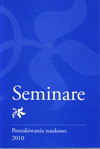Wprowadzenie w problematykę techniki gry i środków techniki kompozytorskiej w etiudach fortepianowych kompozytorów polskich w latach 1916-2006
An introduction to the problems of performance technique and compositional devices in piano etudes by polish composers (1916-2006)
Author(s): Marcin T. ŁukaszewskiSubject(s): History
Published by: Towarzystwo Naukowe Franciszka Salezego (TNFS)
Keywords: Diadochokinesis; Etude; Figuration; Piano; minimal music; neo-classicism; composing technique
Summary/Abstract: The article covers the years 1916 to 2006, i.e. from Karol Szymanowski’s Twelve Etudes Op. 33 (1916) to Krzysztof Baculewski’s Twelve Etudes (2006). During the period under examination piano etudes were written by many Polish composers. Those by Szymanowski, Witold Lutosławski, Andrzej Panufnik, Grażyna Bacewicz and Bolesław Woytowicz are considered to be most representative. In the twentieth century and at the beginning of the twenty first century, the etude has not been an anachronic genre, as evidenced by the constant flow of new works penned by composers. These include both works in which the organization of the musical material draws on tradition and those which explore the techniques of twentieth century-music. The neo-classical trend exerted a far-reaching influence on the character and stylistic features of Polish piano etudes of the first half of the twentieth century. Works by Lutosławski, Bacewicz, Woytowicz, Szeligowski, and to some extent by Panufnik can serve as examples. The etudes by Lutosławski and Bacewicz are beyond doubt of the most outstanding artistic merit. They are part of the concert repertoire and are among the most frequently performed Polish 20th-century etudes. The etudes of Norbert Mateusz Kuźnik, Andrzej Hundziak and Franciszek Woźniak employ the techniques typical of new music, such as a new type of notation, and therefore belong to the avantgarde and post-avantgarde group. Post-modernist Two Etudes by Paweł Szymański also belongs to this group. The work is a good example of ‘sur-conventionality’, a style that is characteristic of Szymański’s music. The etudes by Polish composers, particularly contemporary ones, are used all too rarely as instruction pieces in Polish music schools. They are also rarely included in recital programmes. The reasons should be looked for in the lack of adequate preparation of both the students and teachers, as well as in an insufficient knowledge and understanding of 20th-century music. All this results in a reluctance to explore this part of the Polish musical heritage.
Journal: Seminare. Poszukiwania naukowe
- Issue Year: 27/2010
- Issue No: 1
- Page Range: 233-247
- Page Count: 15
- Language: Polish

